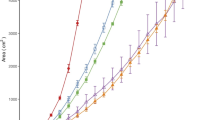Abstract
To examine monokaryotization of dikaryotic mycelia ofPholiota nameko, 18 monokaryotic stocks were used to produce a total of 130 dikaryotic stocks by reciprocal crossing. Monokaryotized mycelium was raised from dikaryotic mycelium in the peripheral zone of the growing colony. The stocks mated with a particular group of monokaryons produced wide-range monokaryotization at higher rates than the other combinations of hybridization. The growth rates of the monokaryotized mycelia exceeded from those of the corresponding parental dikaryons. The monokaryotized mycelium was isolated and back-crossed to parental monokaryotic stocks. Most of the isolates had nuclear types similar to only one of the parental stocks, while the replicates of isolates from two dikaryotic hybrids showed split nuclear type compositions. It is suggested that a relative dominance is active in the selection of one of the two nuclei of the dikaryotic cells in monokaryotization. The hierarchy of relative dominance among nuclei of 18 parental monokaryotic stocks in the monokaryotization of their reciprocal crossing products was estimated. We propose the involvement of a cascade process in dikaryotic cell division, in which the first dividing nucleus (to be found in the monokaryotized cell) may act as the “leading nucleus” and the other one as the “following nucleus.”
Similar content being viewed by others
Literature cited
Arita, I. 1964. Dedikaryotization of dikaryotic mycelia inPholiota nameko. Rep. Tottori Mycol. Inst.4: 44–50. (In Japanese.)
Arita, I. 1968. Studies on the cultivation ofPholiota nameko (T. Ito) S. Ito et Imai. I. On the growth rate of mycelia in relation to temperature. Rep. Tottori Mycol. Inst.6: 58–73. (In Japanese.)
Arita, I. 1979. The mechanism of spontaneous dedikaryotization in hyphae ofPholiota nameko. Mycologia71: 603–611.
Arita, I. and Takemaru, T. 1962. Some problems of the mating system ofPholiota nameko (T. Ito) S. Ito et Imai. Rep. Tottori Mycol. Inst.2: 1–10. (In Japanese.)
Butler, G. M. 1972. Nuclear and non-nuclear factors influencing clamp connection formation inCoprinus disseminatus. Ann. Bot. (London)36: 263–279.
Furtado, J. S. 1966. Significance of the clamp connection in the Basidiomycetes. Persoonia4: 125–144.
Imazeki, R., Otani, Y. and Hongo, T. 1988. “Mushroom fungi in Japan,” pp. 228–229. Yama-Kei Pub., Tokyo. (In Japanese.)
Korhonen, K. and Hintikka, V. 1974. Cytological evidence for somatic diploization in dikaryotic cells ofArmillariella mellea. Arch. Mikrobiol.95: 187–192.
Nobles, M. 1937. The morphology and cytology ofTyphula trifolii Rostr. Ann. Bot. (London)1: 67–98.
Author information
Authors and Affiliations
About this article
Cite this article
Masuda, P., Yamanaka, K., Sato, Y. et al. Nuclear selection in monokaryotization of dikaryotic mycelia ofPholiota nameko as described by leading and following nuclei. Mycoscience 36, 413–420 (1995). https://doi.org/10.1007/BF02268625
Accepted:
Issue Date:
DOI: https://doi.org/10.1007/BF02268625




